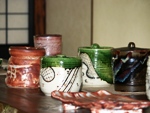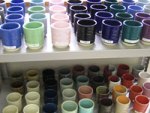The Color of Ceramics – Glazing and Decorating

In pottery decoration, pigments which can withstand high temperatures such as gosu, tessa (also known as oni’ita) and shinsa (cinnabar) are used to paint designs after unglazed firing. Then the pottery is glazed, and once it undergoes complete firing, paints which can melt at low temperatures are used for decoration. Since gosu contains cobalt oxide as its main component, the pottery can give off a cobalt-blue color. Tessa contains a dark, rocky mineral which helps to give off a blackish color while shinsa expresses itself as a red color. Pigments used in design can be said to have the trait of frequently blending with the pottery, but on the other hand, decoration with colors such as red, green, purple, and yellow provide vivid hues. In addition, the kinds of pictures used to illustrate pottery are abundant. Images such as whirlpools, mountain rivers, thunder, and pictures of nature, treasures, knotting, Japanese celebratory ornaments (shochikubai), and other designs of celebration, motifs with Chinese children and saints, shrimp, crabs and other forms of marine life are often used. Images from Japan’s oldest manga, “Animal Caricatures” (Choju-giga) have also been depicted. Things that are rooted in Japan’s history, topography, culture and lifestyle are preferably used.

Even in glazing, there are actually many kinds of glaze used. Glazes have the role of a cover or lid over the surface of ceramics and porcelain, but there are also many kinds of clear and colorless glazes along with the abundant types which provide a variety of colors. Depending on each ingredient and firing style, the colors that come out can differ, and so making minute adjustments to the composition of these ingredients will create changes in the colors expressed. For instance, ash glaze, lead glaze and feldspar glaze make up a foundation by dissolving in water and adding iron or copper. Another glaze, shino, which consists of white feldspar can create a white finish. Even with all of these numerous glazes, the firing will take a lot of time. But however basic the works are, the glazes are very popular. Adding iron oxide or manganese oxide to feldspar glaze creates candy glaze (ameyu) which has a light caramel color with a glossiness, while adding cobalt oxide to the same glaze creates an azure glaze which provides a deep blue finish. In addition, ash glazes which consist of dobai, an ash made from the burning of kindling wood in ovens, and natural ash which comes from trees and shrubs and their bark, have a light ashy color, while cinnabar glaze, which is made by burning lead with a reduction flame, produces a red color. Furthermore, even if you apply the same glaze, differing firing techniques can produce vastly different finishes. For example, applying glaze with added copper and then using an oxidizing flame during firing will cause the copper to oxidize and thus produce a green finish, but using a reduction flame will reduce the copper to produce a purple finish. Also, there is also the mixing of several kinds of glaze which can produce a whole new glaze, methods to apply several discrete glazes onto one piece of work, and the combination of these colors and the manner of application which can create works with various expressions.
